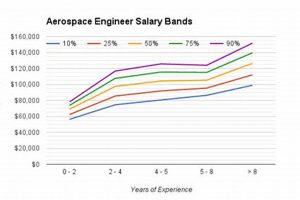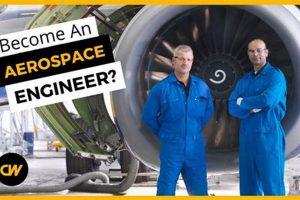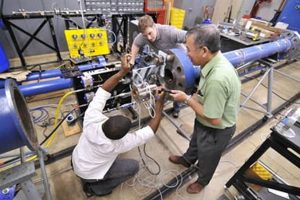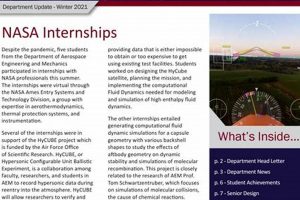The capabilities of individuals completing advanced studies in aerospace engineering are varied and highly sought-after across multiple sectors. Possessing a deep understanding of aerodynamics, propulsion, materials science, and structural analysis, these graduates are equipped to contribute to the design, development, and testing of aircraft, spacecraft, missiles, and related systems. Their expertise extends beyond theoretical knowledge to practical application, often involving complex simulations, advanced manufacturing techniques, and rigorous testing protocols. This skillset enables them to address critical challenges in the aerospace industry and beyond.
The significance of aerospace engineers lies in their ability to innovate and solve complex problems within a demanding field. Their contributions drive progress in air travel, space exploration, national defense, and scientific research. Historically, aerospace engineers have been instrumental in landmark achievements, from the first powered flight to landing humans on the moon. The benefits of their work extend to improved safety and efficiency in transportation, enhanced communication technologies, and advancements in our understanding of the universe.
Therefore, the following sections will delve into specific career paths, required skills, and emerging trends for those with a graduate degree in aerospace engineering, demonstrating the breadth of opportunities available.
Career Guidance for Aerospace Engineering Graduates
The following tips provide strategic advice for aerospace engineering graduates seeking to maximize their career opportunities and professional development.
Tip 1: Cultivate a Strong Technical Foundation: Maintaining a robust understanding of fundamental engineering principles is crucial. Focus on core areas such as fluid dynamics, thermodynamics, and structural mechanics. This foundational knowledge enables adaptability to evolving technologies.
Tip 2: Develop Specialized Skills: Acquire expertise in specific areas relevant to industry demands. Examples include computational fluid dynamics (CFD), finite element analysis (FEA), or advanced materials processing. This specialization enhances competitiveness in the job market.
Tip 3: Gain Practical Experience Through Internships: Seek out internship opportunities in aerospace companies, research institutions, or government agencies. Hands-on experience provides valuable insight into real-world engineering challenges and fosters professional connections.
Tip 4: Enhance Project Management Abilities: Aerospace projects often involve complex tasks and require effective coordination. Develop skills in project planning, risk management, and team leadership. Certification in project management methodologies can be beneficial.
Tip 5: Pursue Continuing Education: The aerospace industry is constantly evolving. Stay abreast of new technologies and advancements through conferences, workshops, and online courses. Lifelong learning is essential for career progression.
Tip 6: Network Strategically: Build relationships with professionals in the aerospace field. Attend industry events, join professional organizations (e.g., AIAA), and connect with alumni. Networking can open doors to job opportunities and mentorship.
Tip 7: Highlight Communication Skills: Engineers must effectively communicate technical information to both technical and non-technical audiences. Develop strong written and oral communication skills through presentations, reports, and technical documentation.
These guidelines underscore the importance of a well-rounded approach to career development, combining technical expertise with practical experience and effective communication skills. This combination is key to a successful career in aerospace engineering.
The next section will consider emerging trends within the field of aerospace engineering.
1. Aircraft Design and Analysis
Aircraft design and analysis constitutes a core capability for graduates possessing advanced degrees in aerospace engineering. Mastery of this area enables the conceptualization, development, and refinement of aircraft, accounting for performance, stability, control, and structural integrity. The correlation arises from the foundational knowledge acquired in aerodynamics, fluid dynamics, thermodynamics, and materials science during graduate studies. These disciplines are directly applicable to tasks such as airfoil design, wing loading calculations, and flight simulation. Deficiencies in aircraft design and analysis could result in inefficient aircraft, structural failures, or compromised safety.
Real-world examples underscore the importance of this connection. Consider the design of a modern commercial airliner; aerospace engineering graduates employ computational fluid dynamics (CFD) software to analyze airflow around the fuselage and wings, optimizing lift-to-drag ratios and reducing fuel consumption. Finite element analysis (FEA) is then used to assess structural stresses under various flight conditions, ensuring the aircraft can withstand aerodynamic forces. The design of unmanned aerial vehicles (UAVs) similarly relies on the application of these principles, where engineers balance performance requirements with size, weight, and power constraints. Analysis, in turn, dictates design improvement.
The practical significance of understanding the capabilities of aerospace engineering graduates in aircraft design and analysis extends beyond technical proficiency. It emphasizes the necessity for a rigorous academic background, specialized software skills, and a comprehensive understanding of regulatory requirements. Challenges persist in developing sustainable aviation technologies and mitigating environmental impact. Therefore, the effective application of aircraft design and analysis principles by qualified aerospace engineering graduates is crucial for advancing the state-of-the-art in aviation.
2. Spacecraft Systems Engineering
Spacecraft systems engineering represents a critical area where the expertise of aerospace engineering graduates is directly applicable. This domain encompasses the design, development, integration, and testing of all components that constitute a functional spacecraft. A graduate’s understanding of orbital mechanics, power systems, communications, thermal control, and attitude determination and control systems (ADCS) becomes paramount in ensuring mission success. Any deficiency in these areas can lead to mission failure, highlighting the direct cause-and-effect relationship between specialized knowledge and operational outcomes.
Spacecraft systems engineering serves as a central component of “what can aerospace engineering graduates do” because it necessitates a holistic understanding of the entire spacecraft as an integrated system. For example, designing a satellite for Earth observation requires an engineer to consider not only the optics and sensors but also the power source, data handling, and orbital positioning. The James Webb Space Telescope exemplifies this; its complex deployment mechanism, cryogenic cooling system, and precise pointing capabilities required extensive systems engineering expertise to ensure successful operation at its designated Lagrange point. The engineers orchestrating these projects have a very large impact.
Understanding the practical significance of spacecraft systems engineering is crucial for managing the increasing complexity and cost of space missions. Future challenges, such as deep space exploration and the development of large orbital habitats, will demand even more sophisticated integration and validation techniques. The development of autonomous spacecraft and the application of artificial intelligence for on-board decision-making further underscore the importance of a systems-level perspective. Therefore, advanced education and specialized training in spacecraft systems engineering are essential for aerospace engineering graduates to effectively contribute to the future of space exploration and exploitation.
3. Propulsion Technology Development
Propulsion technology development represents a critical area where the expertise of aerospace engineering graduates is pivotal. It encompasses the design, analysis, and testing of systems that generate thrust, enabling both atmospheric and space flight. The success of any aerospace mission, from commercial aviation to interplanetary exploration, depends directly on advancements in propulsion technology.
- Rocket Engine Design and Analysis
Aerospace engineering graduates possessing expertise in rocket engine design and analysis contribute to the development of more efficient and reliable propulsion systems for spacecraft. This includes optimizing combustion processes, designing nozzle geometries for maximum thrust, and analyzing structural integrity under extreme operating conditions. The development of reusable rocket engines, such as those used by SpaceX, exemplifies the application of this expertise. Such advancements drastically reduce the cost of space access.
- Air-Breathing Engine Improvement
The enhancement of air-breathing engines, utilized in aircraft, is another significant area. Aerospace engineering graduates focus on improving fuel efficiency, reducing emissions, and increasing thrust-to-weight ratios. This involves designing advanced compressor blades, optimizing combustion chamber designs, and integrating sophisticated control systems. The development of geared turbofan engines demonstrates this effort, achieving substantial fuel savings in commercial aviation.
- Hypersonic Propulsion Systems
Hypersonic propulsion systems, such as scramjets and ramjets, represent a frontier in aerospace engineering. Graduates working in this field contribute to the design and testing of engines capable of operating at speeds exceeding Mach 5. This requires expertise in high-temperature materials, advanced combustion techniques, and complex fluid dynamics simulations. The development of hypersonic cruise missiles and reusable spaceplanes relies on these advancements.
- Electric Propulsion Systems
Electric propulsion systems, including ion thrusters and Hall-effect thrusters, offer high efficiency for long-duration space missions. Aerospace engineering graduates contribute to the design and optimization of these systems, focusing on maximizing thrust efficiency and minimizing propellant consumption. This involves expertise in plasma physics, electromagnetic field analysis, and spacecraft integration. Deep space missions, such as those to asteroids and outer planets, rely on electric propulsion systems.
The diverse applications of propulsion technology highlight the broad range of opportunities for aerospace engineering graduates. From improving the fuel efficiency of commercial aircraft to enabling deep space exploration, their expertise drives advancements that impact both our daily lives and our understanding of the universe. The continued development of more efficient, reliable, and sustainable propulsion systems is essential for the future of aerospace engineering.
4. Materials Innovation and Testing
Materials innovation and testing constitutes a critical function within aerospace engineering, directly impacting the performance, safety, and longevity of aircraft and spacecraft. Aerospace engineering graduates contribute substantially to this field through the development of novel materials and the rigorous evaluation of their properties under simulated operational conditions. This expertise is paramount for meeting the demanding requirements of modern aerospace applications.
- Development of Lightweight Composites
Aerospace engineering graduates engage in the creation and characterization of lightweight composite materials, such as carbon fiber reinforced polymers (CFRPs) and metal matrix composites. These materials offer high strength-to-weight ratios, enabling the design of more efficient aircraft and spacecraft. The Boeing 787 Dreamliner, which incorporates a significant percentage of CFRPs in its fuselage and wings, exemplifies this application. Graduates are involved in optimizing the composition, manufacturing processes, and structural design of these composites.
- High-Temperature Materials for Propulsion Systems
Advanced propulsion systems, including jet engines and rocket engines, require materials capable of withstanding extreme temperatures and pressures. Aerospace engineering graduates contribute to the development of high-temperature alloys, ceramics, and thermal barrier coatings for these applications. These materials enhance engine efficiency and durability, enabling higher operating temperatures and increased thrust. The development of nickel-based superalloys for turbine blades is a direct result of this area of focus.
- Non-Destructive Testing (NDT) Techniques
Ensuring the structural integrity of aerospace components requires the application of non-destructive testing (NDT) techniques. Aerospace engineering graduates develop and implement NDT methods, such as ultrasonic testing, radiography, and eddy current testing, to detect flaws and defects without damaging the material. These techniques are essential for quality control during manufacturing and for assessing the condition of aircraft and spacecraft during service. The inspection of aircraft wings for fatigue cracks is a typical application of NDT.
- Environmental Degradation Testing
Aerospace materials are exposed to harsh environmental conditions, including extreme temperatures, radiation, and corrosive atmospheres. Aerospace engineering graduates conduct environmental degradation testing to assess the long-term performance and durability of materials under these conditions. This involves simulating the effects of temperature cycling, ultraviolet radiation, and chemical exposure to predict material degradation rates and ensure structural integrity over the lifespan of the aircraft or spacecraft. Testing materials for use in satellites orbiting Earth or other planets would use this process.
In summary, aerospace engineering graduates play a crucial role in materials innovation and testing, contributing to the development of advanced materials and the implementation of rigorous testing methodologies. These efforts ensure the safety, reliability, and performance of aircraft and spacecraft operating in demanding environments. The continued advancement of materials technology is essential for pushing the boundaries of aerospace engineering and enabling new possibilities in air travel, space exploration, and national defense.
5. Research and development leadership
Research and development leadership constitutes a paramount capability arising from advanced studies in aerospace engineering. The ability to guide and direct research initiatives, coupled with the responsibility for translating theoretical findings into practical applications, defines a key aspect of what an aerospace engineering graduate can achieve. A mastery of engineering principles, coupled with an understanding of project management, financial resource allocation, and team leadership, enables graduates to drive innovation within the aerospace sector. Deficiencies in leadership skills can lead to inefficient project execution, missed deadlines, and the inability to secure funding for future research, demonstrating a cause-and-effect relationship.
The importance of research and development leadership is evident in numerous real-world scenarios. Consider the development of new propulsion systems; a capable leader is crucial for coordinating the efforts of engineers, scientists, and technicians, ensuring that the project stays on track and meets performance objectives. The success of initiatives such as the development of composite materials, advanced sensors, or novel aerodynamic designs hinges on effective leadership and the ability to foster a collaborative and innovative environment. NASA’s Mars rover program stands as a testament to effective research and development leadership, where engineers and scientists developed rovers that could withstand the extreme conditions of the Martian atmosphere and environment.
Understanding the practical significance of research and development leadership within aerospace engineering is essential for cultivating future generations of innovators. Aerospace graduates equipped with both technical expertise and leadership skills are uniquely positioned to address the complex challenges facing the industry, from developing sustainable aviation technologies to enabling deep space exploration. Continued emphasis on developing these leadership capabilities through educational programs and practical experiences will be critical for ensuring the continued advancement of the aerospace field.
Frequently Asked Questions Regarding Aerospace Engineering Graduate Career Paths
This section addresses common inquiries concerning the diverse career options and potential contributions of individuals holding advanced degrees in aerospace engineering.
Question 1: What specific industries commonly employ aerospace engineering graduates?
Aerospace engineering graduates find employment opportunities in diverse sectors including commercial aviation, space exploration, defense, and government research. Specific roles may involve designing aircraft components, developing spacecraft systems, conducting research on advanced materials, or contributing to the development of missile technology.
Question 2: What skills are considered most valuable for aerospace engineering graduates entering the workforce?
Employers typically seek candidates with a strong foundation in engineering principles, proficiency in computer-aided design (CAD) and simulation software, and excellent problem-solving abilities. Effective communication skills, both written and oral, are also highly valued, as is the capacity to work effectively in team environments. Familiarity with programming languages relevant to aerospace engineering is also advantageous.
Question 3: What are some potential career paths for aerospace engineering graduates beyond traditional engineering roles?
Beyond traditional engineering roles, aerospace engineering graduates can pursue careers in project management, technical consulting, research and development leadership, and government regulation. The analytical and problem-solving skills acquired during graduate studies are transferable to a wide range of professional settings.
Question 4: How can an aerospace engineering graduate differentiate themselves in a competitive job market?
Candidates can differentiate themselves by gaining practical experience through internships, developing specialized skills in high-demand areas (e.g., computational fluid dynamics, finite element analysis, advanced materials), and obtaining professional certifications. Demonstrating a strong portfolio of completed projects and a commitment to lifelong learning are also beneficial.
Question 5: Are there significant differences in career opportunities based on specific areas of specialization within aerospace engineering?
Yes, specialization can significantly impact career opportunities. For example, graduates specializing in propulsion systems may find opportunities in rocket engine design and development, while those specializing in spacecraft systems engineering may focus on satellite integration and mission planning. Focusing on a specific area allows for the development of deep expertise, increasing competitiveness in that area.
Question 6: What is the role of professional organizations in the career development of aerospace engineering graduates?
Professional organizations, such as the American Institute of Aeronautics and Astronautics (AIAA), provide networking opportunities, access to industry publications, and professional development resources. Membership in these organizations can enhance career prospects and facilitate continuous learning.
These FAQs provide a foundational understanding of the career landscape for aerospace engineering graduates. The emphasis on continuous learning, specialization, and the development of transferable skills remains crucial for navigating this dynamic field.
The following section will address key skills acquired by aerospace engineering graduates.
Conclusion
The preceding sections have elucidated the diverse capabilities arising from advanced study in aerospace engineering. Individuals completing graduate programs within this discipline are prepared to contribute to aircraft design, spacecraft systems engineering, propulsion technology development, materials innovation and testing, and research and development leadership. The application of this expertise drives progress across multiple sectors, from commercial aviation to space exploration.
Given the expanding scope of aerospace activities and the increasing demand for innovative solutions, continued investment in aerospace engineering education and research remains critical. The ability to address complex challenges in air and space travel will depend on the continued development and application of the skills and knowledge acquired by aerospace engineering graduates.







